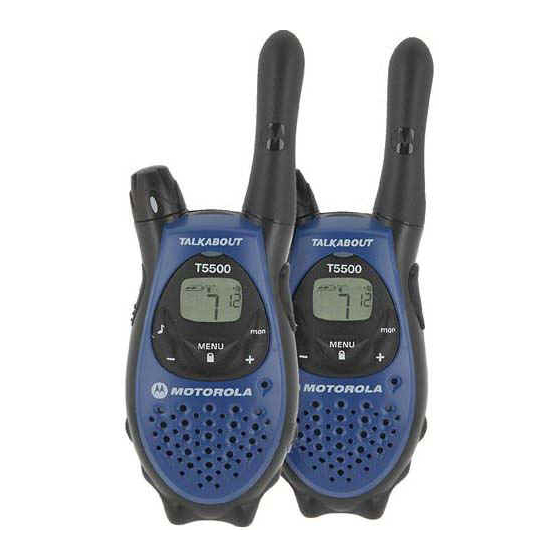Motorola TALKABOUT T5500 Panduan Komunikasi - Halaman 13
Jelajahi secara online atau unduh pdf Panduan Komunikasi untuk Radio Motorola TALKABOUT T5500. Motorola TALKABOUT T5500 16 halaman. Frs/gmrs recreational two-way radios
Juga untuk Motorola TALKABOUT T5500: Panduan Pengguna (36 halaman), Panduan Pengguna (17 halaman), Panduan Pengguna (5 halaman)

"tactical call sign". "ASNC Rescue One" and "ASNC Emergency Control" would be
"tactical call signs" because they are descriptive. For radios using GMRS and
Amateur Radio, their FCC call signs need to be given also at the end of any series of
transmissions or every ten minutes.
8) Avoid unnecessary conversation
During a CERT drill or disaster response talking on the radio about anything that is
not absolutely necessary to support that activity must be avoided. Chating, discussing
anything personal or telling a joke are examples of forbidden radio activity. Keep
reports shot and to the point!
COMMUNICATIONS GLOSSARY:
Previously unexplained technical terms are marked with an asterisk (*) and can be understood by looking
them up further along in the glossary.
AMATEUR RADIO: a FCC licensed radio service which requires passing an
examination on electronics, radio-communications, regulations and operating practices.
Morse code proficiency is no longer required. Amateur radio operators are commonly
referred to as "hams". Hams have always been very involved in providing
communications as a public service, particularly during disasters.
ANTENNA: a piece of equipment which radiates and collects radio transmissions. For
our purposes it is that thumb shaped projection sticking out of the top of a hand held two-
way radio*.
BATTERY PACK: Several small rechargeable batteries packaged together and use to
power small radios instead of individual rechargeable ones.
CALL SIGN: A series of letters and numbers assigned to identify a specific radio
station. These are usually assigned by the FCC* to most radio services such as the
General Mobile Radio Service (example WABC1234) or the Amateur Radio Service
(KA6ABC). In emergency communications "tactical" call signs are sometimes also used
which are not assigned by the FCC (example" SLNC Depot One")
CHANNEL: A numbered designation given to a radio frequency rather than using the
actual cycles per second. For example, the frequency 462.5625 MHz has been assigned to
the GMRS* as Channel 8. It is usually the large number in your FRS/GMRS* radio's
LCD*display.
CTCSS (continuous tone-coded sub-audible squelch) or call "tones", "quiet codes",
"privacy channels", etc.). When you have this feature turned on, your transmitter sends
For disaster communication in the ASNC area, tune to FRS Channel 2 (Alternate: Ch 12)
Ham Radio Operators should also tune to Battalion 2 simplex 145.585 MHz, PL 110.9
13
